I usually make dishes from scratch, but today I am introducing an instant broth for all kinds of hot pot dishes, aka Quick and Easy Hot Pot. For an off-the shelf, ready-made broth, it tastes great. Have your chopped vegetables and meat ready, put everything in a pot, and voila!
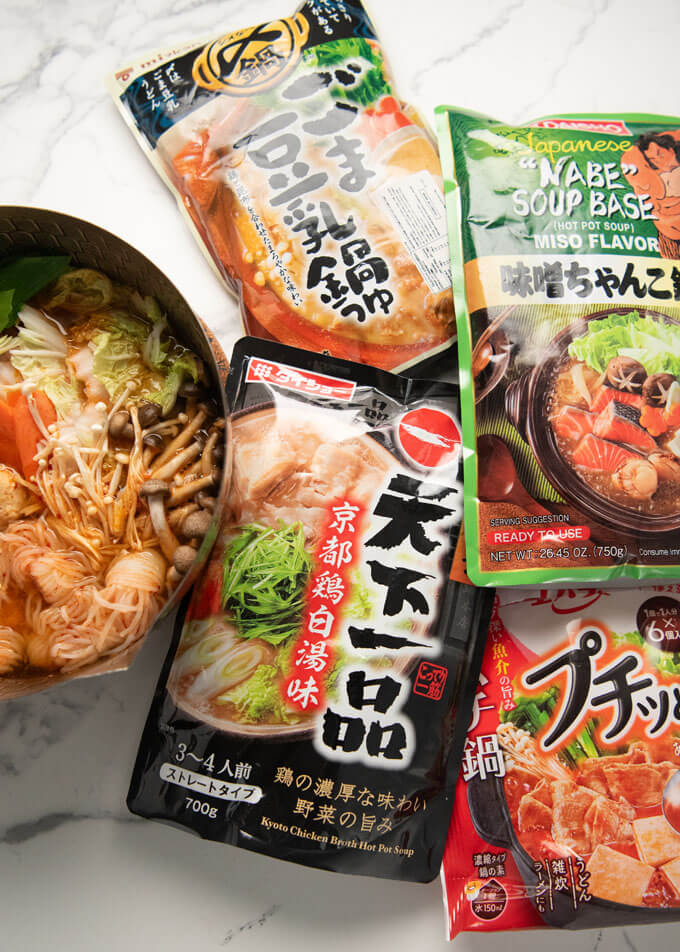
I will show you different flavours of broths in different forms, so that you can make an educated decision on what to make.
Ready-made broth is a handy food item to stock in your pantry in case you don’t have much time to cook but feel like eating a balanced food.
The following are some of the hot pot recipes in my blog that are made from scratch.
You can see a complete list of hot pot recipes on my blog site here. Using ready-made Quick and Easy Hot Pot broths, you can make pretty much all of my hot pot dishes with exception of Sukiyaki and Shabu-shabu.
Ready-made Hot Pot Broths come in Different forms
Some ready-made hot pot broths are packed in a stand-up pouch, just like a chicken stock or beef stock pouch. The hot pot broth in a stand-up pouch can be used straight from the pouch into a pot.

It says 3-4 servings on the back of the pouch, but I think the servings must be by Japanese standard because even I find 1 portion is very small if I serve 4 people with it. In my household, one pouch serves only 2-3.
Other types of ready-made hot pot broth are condensed broth, either as a thick liquid in a capsule or as compressed powder like a stock cube. They need to be diluted with water as per the instructions on the back of the bag.
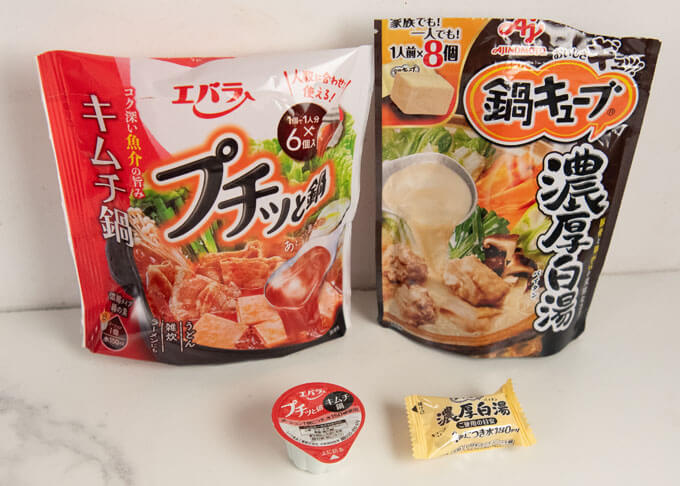
The instructions recommend diluting one capsule or a cube in 150-180ml/5.1-6.1fl oz water for one serving. But I add 10-15% more water because the water evaporates while cooking the ingredients.
Again, by my standard the quantity of one serving is too small. You will probably need 1.5 – 2 times more than the standard quantity suggested on the back of the pack. Perhaps the longevity of Japanese people comes from the fact that they don’t eat too much…
Different flavours of Ready-made Hot Pot Broth
Many of the ready-made hot pot broths come in a particular flavour. Here are the broths that I bought to check out the flavours:
1. Goma tan tan nabe tsuyu (Mizkan brand):
Sesame dan dan noodle soup broth. It has a mild spiciness made from a combination of sesame paste, chilli bean paste, and chilli oil. It has a rich, full-bodied flavour.
Naturally, the leftover broth is perfect to make Tantanmen (Japanese-style dan dan noodles).
2. Shiro dashi tōnyū nabe (Kikkoman brand):
Soy milk mixed with shiro dashi. It uses soy milk with no additives, giving the broth richness and good flavour. Cooking rice in the leftover broth will result in risotto-like rice dish. Udon noodles can also go very well with this broth.
3. Miso chanko nabe (Daisho brand):
Miso-based chanko nabe broth made with chicken, bonito flakes, kelp, and miso. The leftover broth is great to make Zōsui/Ojiya (Japanese Rice Soup).
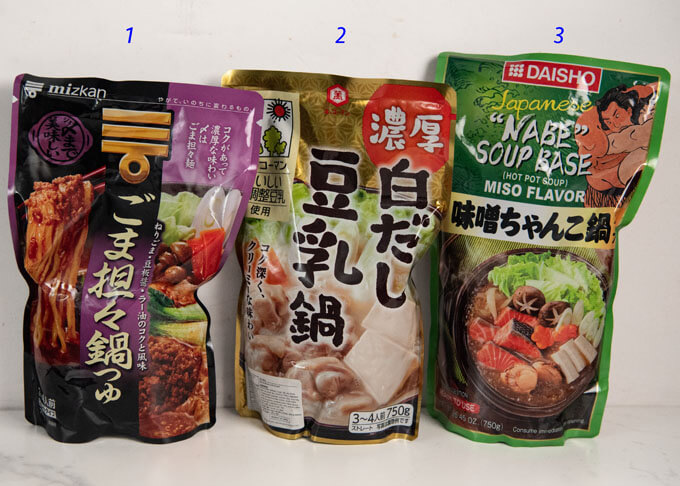
4. Goma tōnyū nabe tsuyu (Mizkan brand):
Sesame flavoured soy milk broth. It is made by combining chicken and kelp stock and finishing with sesame and soy milk, giving it a light yet rich flavour and a mellow taste. Udon noodles go well with this broth.
5. Men-ya Mushashi dashi shōyu aji (Daisho brand):
Soy-based soup made with bonito flakes, dried anchovies, chicken carcasses, garlic, and pepper. It is developed in collaboration with the ramen shop called Men-ya Musashi.
6. Kyoto tori paitan flavour (Daisho brand):
Thick white chicken broth made with chicken carcass, vegetables, and garlic. It is said that this style of broth was invented by a ramen shop in Kyoto, hence Kyoto is included in the name of the broth. The leftover broth is perfect to make paitan ramen.
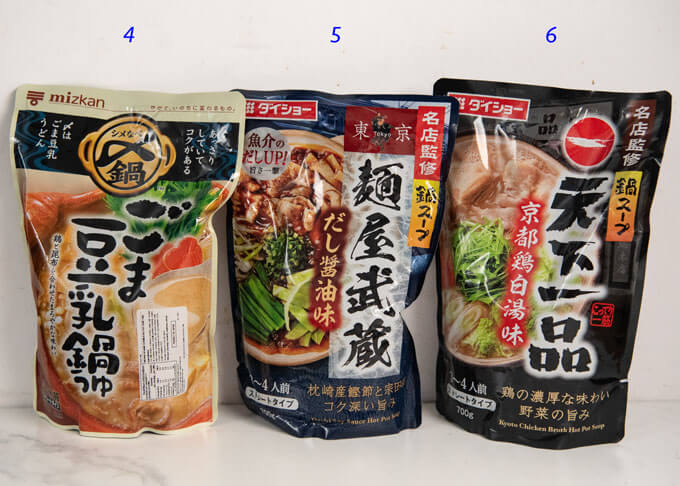
7. Yosenabe (Ebara brand):
Based on light soy sauce to make the broth clearer, it has the bonito and kelp flavour with a touch of ginger. The broth is the clearest among these broths listed today. Because the broth is a classic light simmering broth, you can use it for udon noodle soup, Oden, or even for simmering dishes.
8. Kimuchi nabe (Ebara brand):
The base of the broth is seafood, but the addition of kimch flavour including garlic makes this broth quite different from any other hot pot broth. A light sour flavour resembles the Korean pickles, kimchi. Kimchi is spicy but this broth has a mild spiciness.
I like making Zōsui/Ojiya (Japanese Rice Soup) with the leftover broth, but noodles can go very well with it as well.
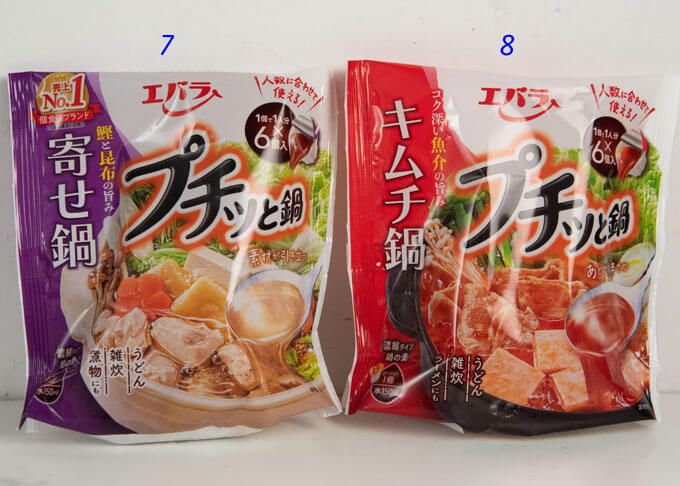
9. Seafood broth (Ajinomoto brand):
The seafood-based brownish clear broth goes well with any ingredients. It particularly makes a great hot pot with white meat fish such as cod, or shellfish like oysters.
The leftover broth is great for noodle soup and rice soup.
10. Thick paitan broth (Ajinomoto brand):
The broth has a rich and deep flavour based on pork bone and chicken stock. The addition of ginger, garlic, and a hint of bonito flavour gives it an appetizing flavour. Instead of making a hot pot, you can use this broth to make ramen like my chicken paitan ramen.
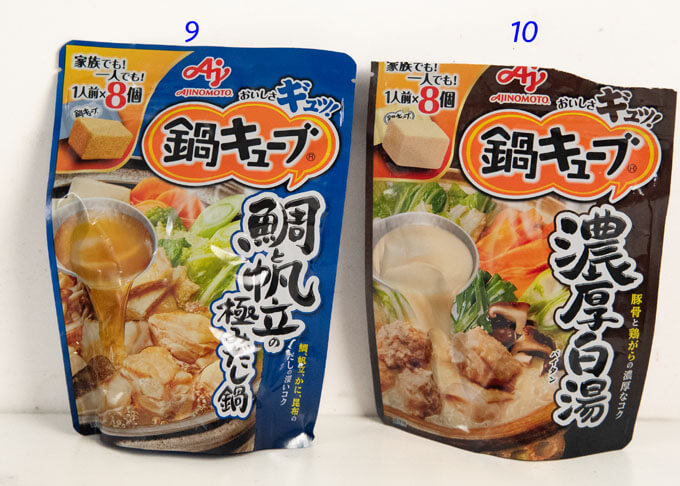
How to use ready-made quick and easy hot pot broth
These broths are meant to be used to cook the ingredients together in a pot instead of cooking a piece of meat and vegetables as you eat them, like Shabu-shabu.
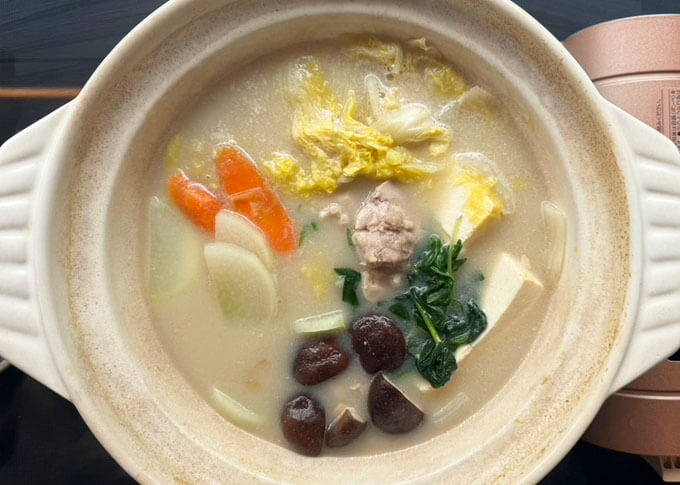
Tōnyū_nabe made with Shirodashi Tōnyū Nabe (Kikkoman brand) broth in a stand-up pouch.
Broth in a stand-up pouch
The broth makes 3-4 servings of hot pot.
- Shake the pouch well and open the pouch.
- Put the broth in a pot and bring it to a boil.
- Add meat and vegetables to the pot and cook for 5-10 minutes.
Condensed broth in a capsule
One capsule makes 1 serving of hot pot.
- Open a capsule and put the thick sauce into the pot.
- Add water (usually 150-180ml/5.1-6.1fl oz) and bring it to a boil.
- Add meat and vegetables to the pot and cook for 5-10 minutes.
Condensed broth in a cubed powder
One cube makes 1 serving of hot pot.
- Put a broth cube and water (usually 180ml/6.1fl oz) in a pot and bring it to a boil.
- Add meat and vegetables to the pot and cook for 5-10 minutes.
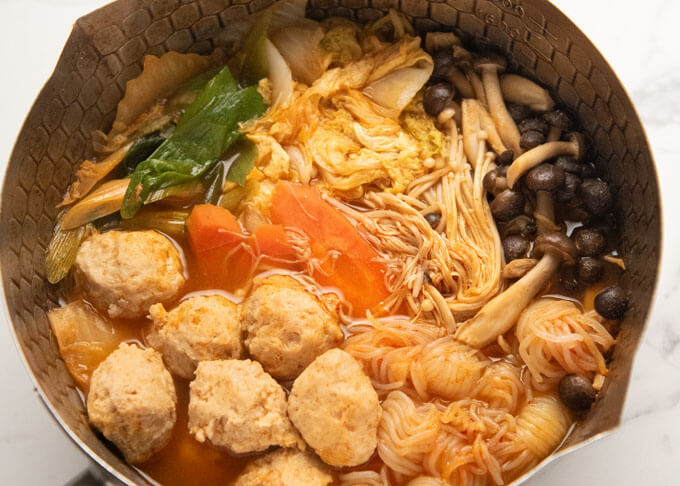
Tsukune hot pot made with Kimchi Nabe (Ebara brand) broth in a capsule.
Typical hot pot ingredients
What goes into the Quick and Easy Hot Pot is up to you, but if the broth is made from seafood, fish or shellfish would enhance the flavour of the hot pot more.
You will find a list of suggested ingredients to make a hot pot on the pack of ready-made broth. The following are some of the suggested ingredients written on the pack, but you can of course change the ingredients, like the ingredients below for my hot pot recipe today.
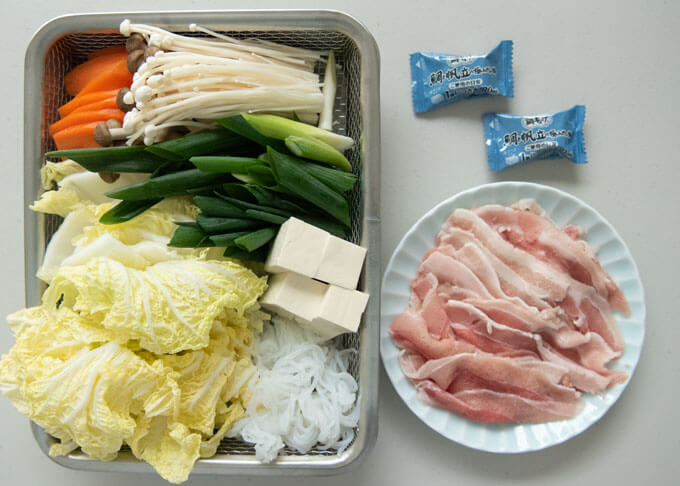
Ingredients used in the recipe card.
Goma tōnyū nabe tsuyu (Mizkan brand):
- Thinly sliced pork
- Chinese cabbage
- Mizuna
- Carrot
- Green onions
- Enoki mushrooms
- Aburaage
- Tofu
Seafood broth (Ajinomoto brand):
- Cod fillet cut into bite size pieces
- Chicken thigh fillet cut into bite size pieces
- Chinese cabbage
- Mizuna
- Carrot
- Green onions
- Shiitake mushrooms
- Tofu
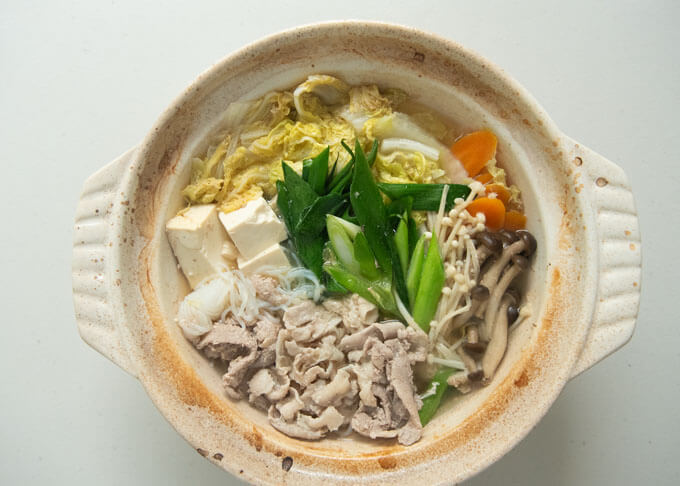
Hot pot made with Seafood broth.
Kimuchi nabe (Ebara brand):
- Thinly sliced pork
- Chinese cabbage
- Green onions
- Garlic Chives (this is must-have)
- Tofu
Don’t waste the leftover broth from quick and easy hot pot
You might sip some broth as you eat the meat and vegetables in the hot pot, but you often end up with a good amount of broth left over. This broth should taste even better than the broth that you started with, because the flavour of the meat and vegetables are added to the original broth.
Add udon noodles, sōmen noodles, or ramen noodles. You can also add rice to make Zōsui.
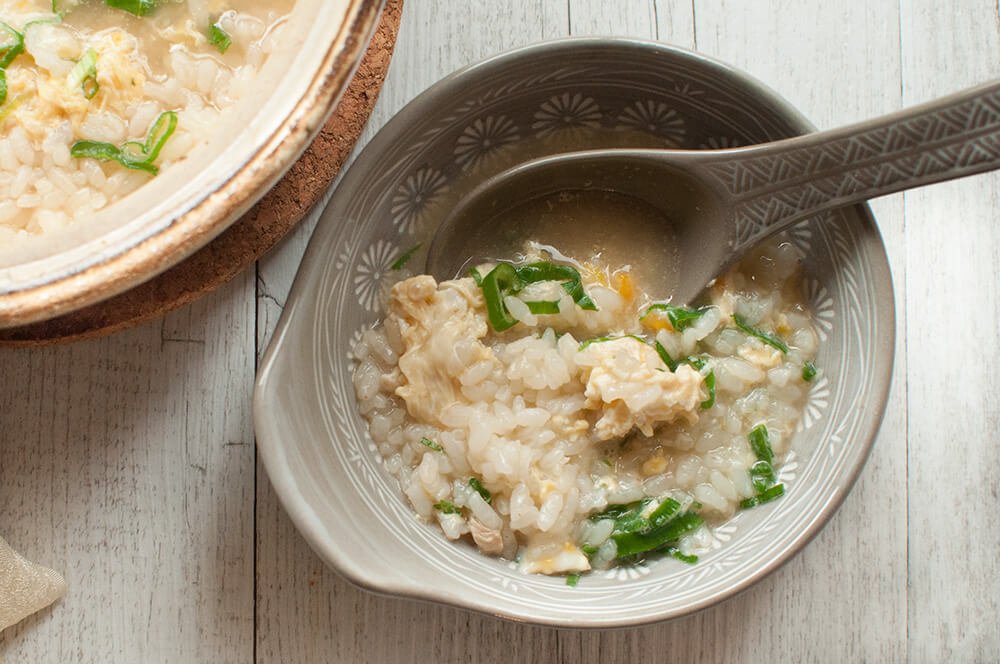
In the recipe card below, you will find a sample hot pot made with typical meat and vegetables. I added variations to the meat and vegetables you can use, as well as instructions for making a hot pot broth using different types of ready-made broth.
Enjoy Quick and Easy Hot Pot at Home!
Yumiko![]()
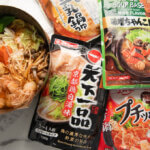
In this recipe, you will find out how to prepare the ingredients and make a delicious hot pot quickly using ready-made hot pot broth. The focus in this recipe is more on the preparation of meat and vegetables than actual cooking because there isn’t much to show you when it comes to cooking ingredients in a pot.
- 200-250g/7.1-8.8oz thinly sliced pork (note 1)
- 200g/7.1oz Chinese cabbage (note 2)
- 50g/1.8oz carrot (note 2)
- 30g/1.1oz Shimeji mushrooms (note 2)
- 30g/1.1oz enoki mushrooms (note 2)
- 60g/2.1oz green onion (note 2)
- 100g/3.5oz momen tofu (note 2)
- 100g/3.5oz shirataki (note 3)
- 2 broth cubes (note 4)
- 400ml/0.8pt water (note 5)
- 2 broth capsules
- 350ml/0.7pt water (note 5)
- About 350ml/0.7pt broth
- 30-50ml/1-1.7 fl oz water
-
Chinese cabbage: Cut the leaves crosswise into 4cm/1½“ long pieces.
-
Carrot: Halve the carrot vertically (or omit this if the root is thin), then slice into 5mm thick pieces.
-
Shimeji mushrooms: Remove the bottom part of the stems that are clustering all the mushrooms together and divide into a few clusters.
-
Enoki mushrooms: Trim the end of the stems that are woody. If mushrooms are stuck together at the bottom, divide it into smaller bunches.
-
Green onion: Cut diagonally into 6cm / 2⅜" long pieces.
-
Tofu: Quarter the block of tofu.
-
Shirataki: I used knotted shirataki, but if you are using strands of shirataki, cut them into manageable pieces 10cm/4” long.

-
Put the broth ingredients of your choice in a pot. If you are using condensed broth, bring it to a boil to dilute the condensed broth into water (note 6).

-
Add the vegetables and meat, clustering each ingredient together.

-
When the broth starts bubbling around the edge, reduce the heat to medium low to low and cook until the meat and vegetables are cooked through.

1. You can substitute pork with chicken, tsukune (Japanese chicken mince balls) or fish fillet. Chicken should be cut into bite-size pieces.
Tsukune can be made with chicken mince, pork mince, or combination of chicken and pork.
Beef is not often used, but thinly sliced beef can go well with the kimchi flavoured hot pot.
Fish fillet can be any fish with white firm flesh, such as cod, snapper, perch, and flat head, as well as salmon. You can also use shellfish, but I usually add only a small amount of shellfish (clams in shells or oysters without shells) in addition to meat.
2. You can pick and choose other vegetables that are commonly used for hot pots. Please refer to my Collection – Hot Pot, where you can see various vegetables used in different hot pot dishes, including preparation.
3. Shirataki are koynnyaku made into thin noodles. They are used in hot pot, soups, and stir-fries. Because the long strands are difficult to pick up, people used to take a small bunch of strands and knot them by hand before cooking. These days you can buy a pack of knotted shirataki, which I used today.
You can of course use un-knotted shirataki. But you may want to cut the long strands into a manageable length.
4. I used Seafood Broth (Ajinomoto brand) cubes, although I didn’t include fish fillet in the ingredients.
Please refer to the hot pot dishes listed in my Collection – Hot Pot, which show you how to prepare particular meat and vegetables.
5. The instruction on the pack says 180ml/6.1fl oz of water per cube, but I add extra water because it evaporates while cooking the meat and vegetables and I feel that the broth becomes a touch salty for my liking.
6. In the case of cubed powder, you need to break the cube into small bits while the water is heating up.
200
Is there a way to get these broth packets in the states? Unfortunately I just returned from Japan and came across your blog after the fact 😢.
Hi Sharonda, I can’t tell you if local Japanese/Asian grocery stores sell these packs, but I found the liquid form of the broth on Amazon.com. HEre is the link: https://www.amazon.com/Ultimate-Japanese-Soup-Base-Assort/dp/B0CWV8B28V.
We are going to eat every one of your recipes!! cannot believe the sodium levels in the pre-packaged broths–even tho delicious. Thank you for alternatives!!
Hi John, wow, I am honoured. I would appreciate your feedback on each recipe you made!
I picked up a few of these packages on our last Japan trip. I believe we got a paitan, a kimchi (same as pictured), and a tantanmen. I tried the tantanmen broth w some noodles and it was surprisingly rich and complex for 0 effort. Tonight, we had “almost instant” kimchi hotpot. I sautéed fresh shiitake mushrooms w daikon, then added chopped kimchi, shredded cabbage, and then the water and broth pods. After simmering like 5 mins, I added frozen mini wontons from Trader Joe’s and simmered until they were heated through. Served with lots of sliced green onion, it was delicious, and again, very fast/easy. While I do like building a more wholesome hot pot from my recipe books, this was a great alternative for our dinner tonight. I am definitely going to experiment with noodles/ramen with the other hot pot pods.
Good for you! It’s a handy food item when you are short of time.
We are visiting our son in Japan so this post was so helpful at being able to find the sauces in the supermarket and then make it. Our hotpot was delicious! Thank you!!
Hi Linda, that’s great. There must be many more choices of the broth in Japan!
HI yumiko. What interesting reading. Would you use these for a Mongolian hotpot? One of my family’s favourite meals when we get together. I usually use chicken stock +aromatics. Do the stocks you use have any nasty numbers or additives? Thank you.
Hi Gillian, I think you could use Kyoto Tori Paitan Flavour would be the closest, although the broth is whiter. You would want to add aromatics, excluding garlic as it already has it. It contains amino acid etc., for seasoning, but there is no artificial colouring.
What a great, useful post! Thanks a lot. Always wondered about these products.
Hi Poornima, thank you! I hope you try some of them.